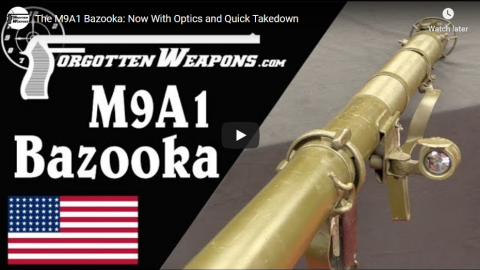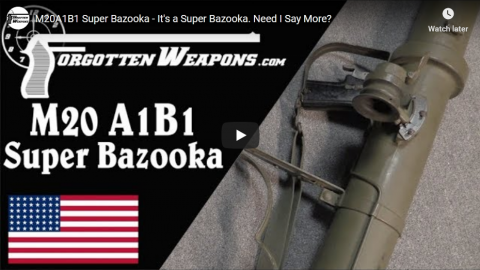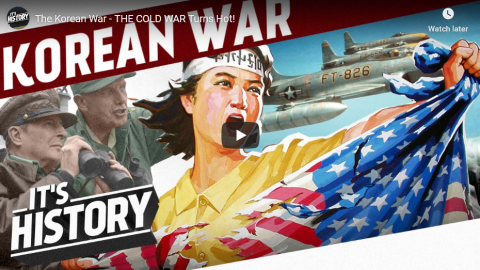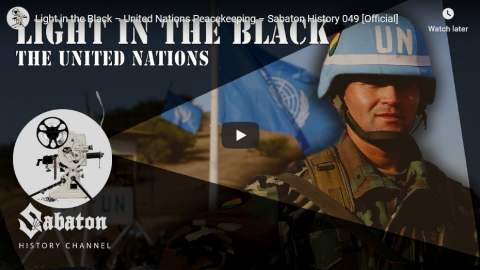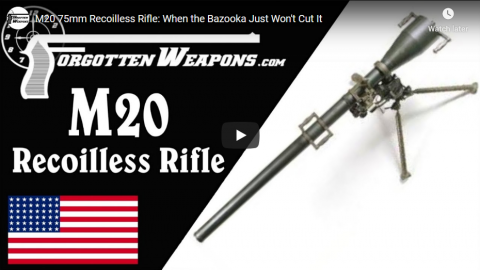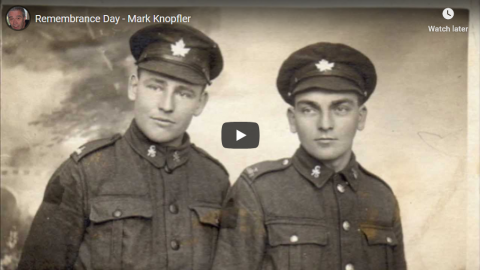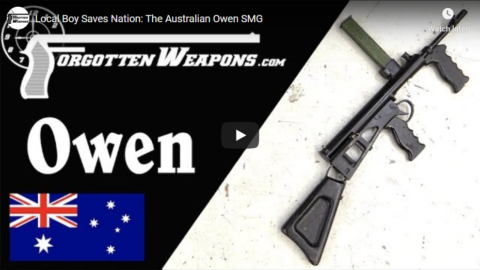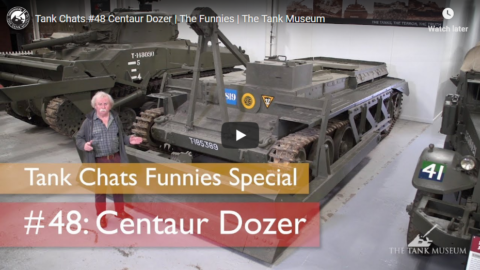Forgotten Weapons
Published 18 Aug 2018Sold for $7,475
http://www.patreon.com/ForgottenWeapons
Cool Forgotten Weapons merch! http://shop.bbtv.com/collections/forg…
The Bazooka — or rather the Launcher, Rocket, 2.36″, M1 — was introduced by the United States in 1942, the result of a fast development by two Army officers, Captain Leslie Skinner and Lt. Edward Uhl. The US had no infantry antitank weapon at that point, and it had become quite clear that such a thing was needed. The Bazooka offered a theoretical effective range of 300 yards, throwing a 1 pound hollow-charge projectile capable of penetrating 4 inches of armor plate. The 2.36 inch bore measurement, incidentally, was chosen as the inch equivalent of 60mm, to match the common mortar size.
In October of 1943, an improved M9 version was introduced, using a magnet firing system instead of the unreliable batteries of the original. A followup M9A1 variant was adopted in June of 1944, which broke down into two parts for easier transportation, and the T90 optical sight was added in September of 1944. These were effective weapons against armor early in the war, but the heavier tanks introduced late in the war were too heavily armored for the Bazooka to be very effective — although it remained a valuable tool for attacking pillboxes and other fortified positions. It would continue to see extensive service in the Korean War, although its limited armor penetration was particularly acute in that conflict.
Note that the inert M6 rocket in the video is not being sold with the Bazooka.
If you enjoy Forgotten Weapons, check out its sister channel, InRangeTV! http://www.youtube.com/InRangeTVShow
March 21, 2020
The M9A1 Bazooka: Now With Optics and Quick Takedown
January 29, 2020
M20A1B1 Super Bazooka – It’s a Super Bazooka. Need I Say More?
Forgotten Weapons
Published 28 Oct 2017Sold for $1,380 (deactivated).
The US was one of the few major military powers that went into World War II without a substantial infantry antitank weapon. Most countries had an antitank rifle of some sort, but the US just had some marginal antitank rifle grenades. That was rectified in late 1942 when the M1 Rocket Launcher — aka the Bazooka — was introduced. Using a 2.36″ shaped charge warhead, it was able to penetrate about 4.7 inches of armor, which was effective through most of the war. A larger version went into development in 1943 though, because it was clear that the M1 would soon become obsolete.
The 3.5″ M20 Super Bazooka was adopted in late 1945 and put into production in 1948, with its first combat use coming in the Korean War. It was much more powerful, capable of penetrating 11 inches of armor plate. The launcher itself weighed just 13 pounds, with each rocket adding another 8.9 pounds. This, and the updated M20A1, would serve as the main US infantry antitank weapon until replaced by the 90mm recoilless rifle in the 1960s.
http://www.patreon.com/ForgottenWeapons
Cool Forgotten Weapons merch! http://shop.bbtv.com/collections/forg…
If you enjoy Forgotten Weapons, check out its sister channel, InRangeTV! http://www.youtube.com/InRangeTVShow
From the comments:
WeirdHarold49
2 years agoSince Ian forgot and Wikipedia knows:
Origin of the “bazooka” name
Shortly after the first prototype launcher and rockets had been tested by firing into the Potomac River, Skinner and Uhl took the new system to a competitive trial of various types of spigot mortar (at that time seen as the most promising way to deliver a shaped charge), which was held at the Aberdeen Proving Ground in May 1942. The new rocket launcher scored several hits on a moving tank while the five different mortars achieved none; this was a considerable achievement since the launcher’s sights had been fabricated that morning from a wire coat hanger. The trial was being watched by various senior officers, among them the Chief of Research and Engineering in the Ordnance Department, Major General Gladeon M. Barnes. Barnes was delighted by the performance of the system and fired it himself, but commented: “It sure looks like Bob Burns’ bazooka”. Bob Burns was a popular radio comedian, who used a novelty musical instrument which he had devised himself and called a “bazooka”.
January 21, 2020
The Korean War – THE COLD WAR Turns Hot!
IT’S HISTORY
Published 23 May 2015Not so long after World War 2, the Cold War had its first very hot conflict. After the separation of Korea into a communist north and a pro-western south, the stage was set for war. A war that escalated quickly and brought new innovations to the front that were only in a testing phase a few years earlier. The conflict cooled down into an armistice and created the DMZ that we still know today.
» SOURCES
Videos: British Pathé (https://www.youtube.com/user/britishp…)
Pictures: mainly Picture Alliance
Content:
Mulholland, Andrew: The Korean War: History in an Hour, William Collins, 2013
Malkasian, Carter: The Korean War, Osprey Publishing, 2014
Hastings, Max: The Korean War, Pan, 1987» ABOUT US
IT’S HISTORY is a ride through history – Join us discovering the world’s most important eras in IN TIME, BIOGRAPHIES of the GREATEST MINDS and the most important INVENTIONS.» HOW CAN I SUPPORT YOUR CHANNEL?
You can support us by sharing our videos with your friends and spreading the word about our work.» CAN I EMBED YOUR VIDEOS ON MY WEBSITE?
Of course, you can embed our videos on your website. We are happy if you show our channel to your friends, fellow students, classmates, professors, teachers or neighbors. Or just share our videos on Twitter, Reddit etc. Subscribe to our channel and like our videos with a thumbs up.» CAN I SHOW YOUR VIDEOS IN CLASS?
Of course! Tell your teachers or professors about our channel and our videos. We’re happy if we can contribute with our videos.» CREDITS
Presented by: Indy Neidell
Based on the script by: Daniel Hungerford
Directed By: Daniel Czepelczauer
Director of Photography: Markus Kretzschmar
Music: Markus Kretzschmar and Daniel Czepelczauer
Sound Design: Bojan Novic
Editing: Franz JänichA Mediakraft Networks original channel
Based on a concept by Florian Wittig and Daniel Czepelczauer
Executive Producers: Astrid Deinhard-Olsson, Spartacus Olsson
Producer: Daniel Czepelczauer
Social Media Manager: Florian Wittig and Laura PaganContains material licensed from British Pathé
All rights reserved – © Mediakraft Networks GmbH, 2015
January 10, 2020
“Light in the Black” – United Nations Peacekeeping – Sabaton History 049 [Official]
Sabaton History
Published 9 Jan 2020The United Nations were created to avoid any future human suffering and all-out conflict. Numerous peacekeeping missions had the goal to deescalate and protect the innocent. However, the success and usefulness of the UN is still quite ambiguous. The Sabaton song “Light in the Black” is about the UN peacekeeping missions and we tell you about the history.
Support Sabaton History on Patreon: https://www.patreon.com/sabatonhistory
Listen to Attero Dominatus (where “Light in the Black” is featured):
CD: http://bit.ly/AtteroDominatusStore
Spotify: http://bit.ly/AtteroDominatusSpotify
Apple Music: http://bit.ly/AtteroDominatusAppleMusic
iTunes: http://bit.ly/AtteroDominatusiTunes
Amazon: http://bit.ly/AtteroDominatusAmzn
Google Play: http://bit.ly/AtteroDominatusGooglePlayListen to Sabaton on Spotify: http://smarturl.it/SabatonSpotify
Official Sabaton Merchandise Shop: http://bit.ly/SabatonOfficialShopHosted by: Indy Neidell
Written by: Markus Linke and Indy Neidell
Directed by: Astrid Deinhard and Wieke Kapteijns
Produced by: Pär Sundström, Astrid Deinhard and Spartacus Olsson
Creative Producer: Joram Appel
Executive Producers: Pär Sundström, Joakim Broden, Tomas Sunmo, Indy Neidell, Astrid Deinhard, and Spartacus Olsson
Production Intern: Rune Væver Hartvig
Post-Production Director: Wieke Kapteijns
Edited by: Iryna Dulka
Sound Editing by: Marek Kaminski and Karolina Dolega
Maps by: Eastory – https://www.youtube.com/c/eastoryArchive by: Reuters/Screenocean https://www.screenocean.com
Music by Sabaton.Sources:
RijksmuseumAn OnLion Entertainment GmbH and Raging Beaver Publishing AB co-Production.
© Raging Beaver Publishing AB, 2019 – all rights reserved.
January 3, 2020
M20 75mm Recoilless Rifle: When the Bazooka Just Won’t Cut It
Forgotten Weapons
Published 8 Mar 2018Sold for $6,325.
Note that this is a rewelded action. It should be inspected by a professional before being fired (the firing footage in the video is a different example).
The M20 75mm Recoilless Rifle was developed starting in 1944 as a replacement for the 3.5″ bazooka in an antitank role. It was developed and produced in parallel with a 57mm recoilless rifle (the M18), and both entered service in March of 1945, seeing just a slight bit of combat use before the end of World War Two. It would be a mainstay of US troops in the Korean War, however, along with a 105mm recoilless rifle. The M20 fired HE, HEAT, and WP (smoke) rounds, with the projectiles weighing 20-22 pounds (about 10kg) and having muzzle velocities of about 1000 fps (305 m/s). The shaped charge HEAT warhead could penetrate about 4″ (100mm) of armor, and had an effective range of about 400 yards. The HE warhead could be effectively used out to about 1000 yards, and the gun was equipped with both direct fire and indirect fire optical sights in order to effectively use both types of ammunition.
By the Vietnam War, the M20 was on its way out, as were recoilless rifles in general — they were being replaced with wire-guided missiles for antitank use. However, the M20 remains in service today for avalanche control in many Western states — a neat repurposing of obsolete weaponry!
http://www.patreon.com/ForgottenWeapons
Cool Forgotten Weapons merch! http://shop.bbtv.com/collections/forg…
If you enjoy Forgotten Weapons, check out its sister channel, InRangeTV! http://www.youtube.com/InRangeTVShow
November 11, 2019
Mark Knopfler – “Remembrance Day”
Bob Oldfield
Published on 3 Nov 2011A Remembrance Day slideshow using Mark Knopfler’s wonderful “Remembrance Day” song from the album Get Lucky (2009). The early part of the song conveys many British images, but I have added some very Canadian images also which fit with many of the lyrics. The theme and message is universal… ‘we will remember them’.
QotD: The British army from WW1 to the end of the Cold War
Before WW1 the army was optimised primarily as a colonial police force, coupled with a small expeditionary force of regular soldiers intended to deploy to the continent to work alongside the French or other allies in the event of war. WW1 was an event that really constituted three armies – the small regular/territorial force of barely 300,000 soldiers that mobilised in 1914 and was wiped out to buy time. The interim force of Territorials and Reservists that held the line in 1915-1916 while the army reconstituted, and the civilian volunteer/conscript force from 1916 onwards that saw the army grow to over 4 million men by 1918.
Rapid demobilisation followed, followed by regeneration in the 1920s and 30s to become the most mechanised army in the world by 1939, comprising some 224,000 regulars. It is often forgotten that the British army of 1940 had many more tanks and vehicles than the German Army – history is not kind to the losers. The army in WW2 grew to a citizen force of roughly 3.5 million men, before shrinking post war.
The continuation of National Service, the war in Korea and the end of empire saw the army stay at roughly 330,000 soldiers for much of the 1950s, causing significant damage to the national economy due to the cost and lack of manpower for rebuilding. By 1957 the army estimated that its regular strength was roughly 80,000 personnel (only a quarter of the whole force), many of whom were tied up training two-year National Servicemen. A major factor in the 1957 Sandys Defence White Paper was the need to reduce manpower costs and free people up for other economically important tasks.
The Sandys Review led to a reduction to 165,000 troops most of whom were focused on either colonial policing actions (it is often forgotten that in the early 1960s there were over 100,000 UK service personnel in the Far East) or deployed in Germany as part of the British Army of the Rhine (BAOR). The withdrawal from empire saw the army shrink to a strength of approximately 150,000 by the 1980s, where its role was primarily to provide a corps of four divisions in Germany in the event of general war, supported by mobilisation units from the UK which would provide further divisions to augment BAOR and conduct home defence roles.
The end of the Cold War saw the first deployment of a divisional-sized force, with an armoured division sent to the Gulf in 1990 for Operation Desert Storm. This happened just as the Options for Change review cut BAOR and reduced the army to approximately 120,000. Further deployments to Bosnia and Kosovo in the 1990s followed by the deployment of an armoured division to Iraq in 2003. Operations in Iraq and Afghanistan from 2003-2014 saw the army struggle to sustain itself on two fronts without heavy support from the RN and RAF providing extra manpower and resources.
The 2010 SDSR initially preserved the army at just under 100,000 personnel, although later reviews cut this down to 82,000 regulars supported by a target of approximately 30,000 reservists working in a far more integrated manner. Today the army is struggling to sustain itself at 82,000, with recent manpower figures showing a total of roughly 78,000 troops.
Sir Humphrey, “How Do You Solve a Problem Like a Deployable Division?”, Thin Pinstriped Line, 2017-08-06.
September 6, 2019
QotD: The horrors of war
There’s no point in pretending that war isn’t horrible — flag-draped coffins are, in fact, a rather pristine symbol of those horrors. There’s a good reason societies honor their warriors.
An aside: I’ve long thought that prettifying World War II for domestic consumption contributed to both the media shock of Vietnam and the generation gap. WWII and Korea vets, who knew war first-hand, didn’t understand just how shocked their doted-on boomer kids were. “The Good War” wasn’t any more pleasant when you were experiencing it.
Virginia Postrel, “Horrors of War”, Dynamist.com, 2004-04-27.
August 4, 2019
QotD: The post-WW2 American army
The men of the Inmun Gun and the CCF were peasant boys, tough, inured to hunger and hardship. One-third of them had been in battle and knew what battle meant. They had been indoctrinated in Communism, but no high percentage of them were fanatic. Most of them, after all, were conscripts, and unskilled.
They were not half so good soldiers as the bronzed men who followed Rommel in the desert, or the veterans who slashed down toward Bastogne.
They were well armed, but their weapons were no better than those of United States design, if as good.
But the American soldier of 1950, though the same breed of man, was not half so good as the battalions that had absorbed Rommel’s bloody lessons, or stood like steel in the Ardennes.
The weapons his nation had were not in his hands, and those that were were old and worn.
Since the end of World War II ground weapons had been developed, but none had been procured. There were plenty of the old arms around, and it has always been a Yankee habit to make do. The Army was told to make do.
In 1950 its vehicles in many cases would not run. Radiators were clogged, engines gone. When ordered to Korea, some units towed their transport down to the LST’s, because there was no other way to get it to the boat. Tires and tubes had a few miles left in them, and were kept — until they came apart on Korean roads.
In Japan, where the divisions were supposedly guarding our former enemies, most of the small arms had been reported combat unserviceable. Rifle barrels were worn smooth. Mortar mounts were broken, and there were no longer any spare barrels for machine guns.
Radios were short, and those that were available would not work.
Ammunition, except small arms, was “hava-no.”
These things had been reported. The Senate knew them; the people heard them. But usually the Army was told, “Next year.”
Even a rich society cannot afford nuclear bombs, supercarriers, foreign aid, five million new cars a year, long-range bombers, the highest standard of living in the world, and a million new rifles.
Admittedly, somewhere you have to cut and choose.
But guns are hardware, and man, not hardware, is the ultimate weapon. In 1950 there were not enough men, either — less than 600,000 to carry worldwide responsibilities, including recruiting; for service in the ranks has never been on the Metropolitan Life Insurance Company’s preferred list of occupations.
T.R. Fehrenbach, This Kind of War: A Study in Unpreparedness, 1963.
July 13, 2019
Local Boy Saves Nation: The Australian Owen SMG
Forgotten Weapons
Published on 8 May 2019Preorders now open for my book, Chassepot to FAMAS: French Military Rifles 1866-2016! Get your copy here: https://www.kickstarter.com/projects/…
http://www.patreon.com/ForgottenWeapons
Cool Forgotten Weapons merch! http://shop.bbtv.com/collections/forg…
The Owen submachine gun is one of the ugliest SMGs ever designed, and yet also one of the most beloved by its users. The original basis for the gun was a .22 rimfire submachine gun designed by 23-year-old Australian Evelyn Owen. That prototype was found by his neighbor Vincent Wardell after Owen left for military service. Wardell was the manager of Lysaght Works, an engineering firm, and thought that the gun might be the basis for a useful military SMG. As it turned out, he was right – it became the standard SMG of The Australian military through World War Two and the Korean War, and was one of the best such guns of that period. For more details on the history of the Owen, see my full article:
https://www.forgottenweapons.com/subm…
Thanks to Movie Armament Group in Toronto for giving me the opportunity to bring you this video! Check out MAG on Instagram: https://instagram.com/moviearmamentsg…
Contact:
Forgotten Weapons
PO Box 87647
Tucson, AZ 85754
June 8, 2019
Tank Chats #48 Centaur Dozer | The Funnies | The Tank Museum
The Tank Museum
Published on 9 Mar 2018A Centaur tank converted into a dozer, part of the Tank Chat Funnies specials. The design had been worked out by 79th Armoured Division in Belgium in autumn 1944. In early 1945, the first conversions were issued to 87th Assault Dozer Squadron, 6th Assault Regiment Royal Engineers; a few saw action in Germany. Some were deployed during the Korean War and the intervention around the Suez Canal in 1956.
Support the work of The Tank Museum on Patreon: ► https://www.patreon.com/tankmuseum
Or donate http://tankmuseum.org/support-us/donateVisit The Tank Museum SHOP: ►https://tankmuseumshop.org/
Twitter: ► https://twitter.com/TankMuseum
Tiger Tank Blog: ► http://blog.tiger-tank.com/
Tank 100 First World War Centenary Blog: ► http://tank100.com/ #tankmuseum #tanks
January 26, 2019
The Cold War – OverSimplified (Part 1)
OverSimplified
Published on 24 Jan 2019
December 19, 2018
HMCS Haida – Guide 027 (Special)
Drachinifel
Published on 13 Aug 2017The most successful Canadian warship, HMCS Haida, is the subject of today’s video
The robotic narration on this video is painfully irritating!
Update, 14 February 2021: Drachinifel updated the narration at some point after I posted the original.
November 11, 2018
Mark Knopfler – “Remembrance Day”
Bob Oldfield
Published on 3 Nov 2011A Remembrance Day slideshow using Mark Knopfler’s wonderful “Remembrance Day” song from the album Get Lucky (2009). The early part of the song conveys many British images, but I have added some very Canadian images also which fit with many of the lyrics. The theme and message is universal… ‘we will remember them’.
July 5, 2018
World of Warships – HMCS Haida
The Mighty Jingles
Published on 3 Jul 2018Oh Canada! Your ship finally made it into World of Warships even if your flag didn’t. I could just tell you what I think of her right now but that would spoil the video, so go on, watch it!
Little White Mouse Haida Review: https://forum.worldofwarships.com/top…
All music licensed from www.epidemicsound.com and www.machinimasound.com Really, I’m not kidding. Stop trying to claim license-free music you record company scumbags!

